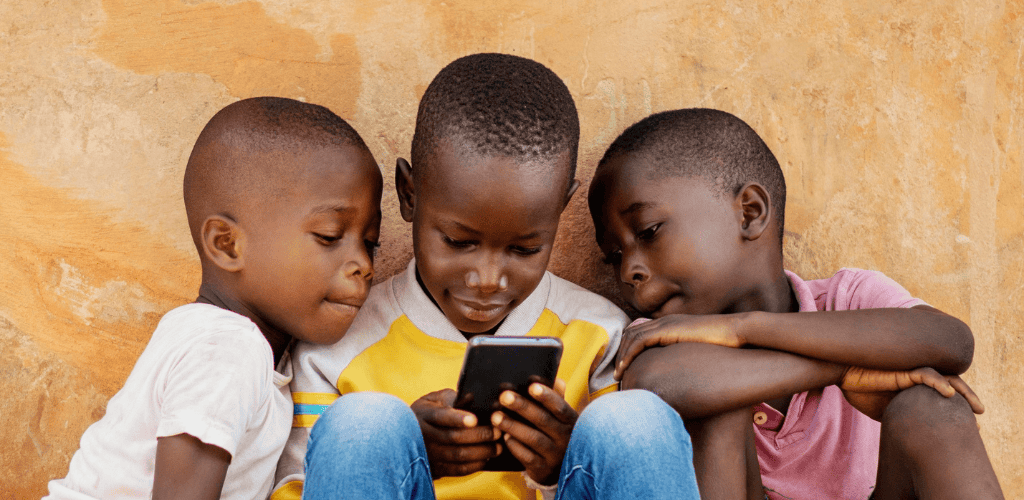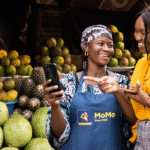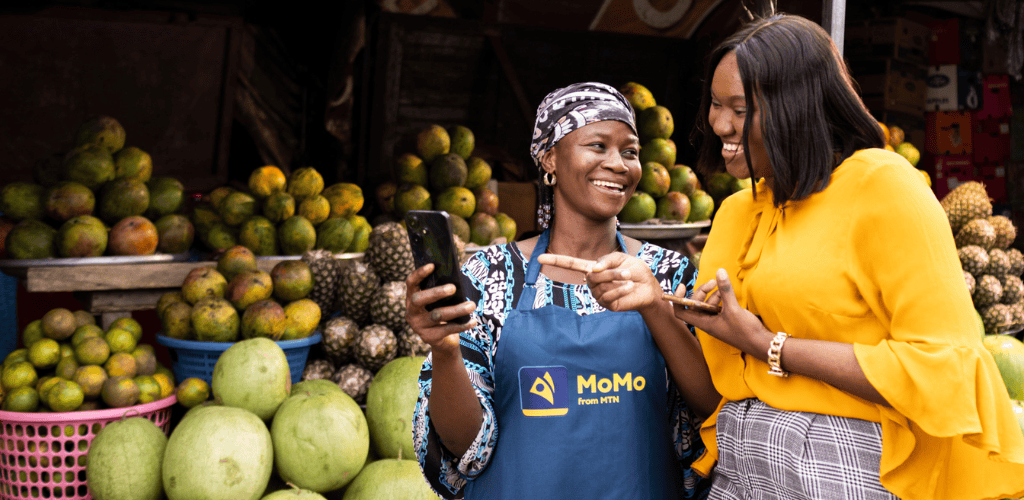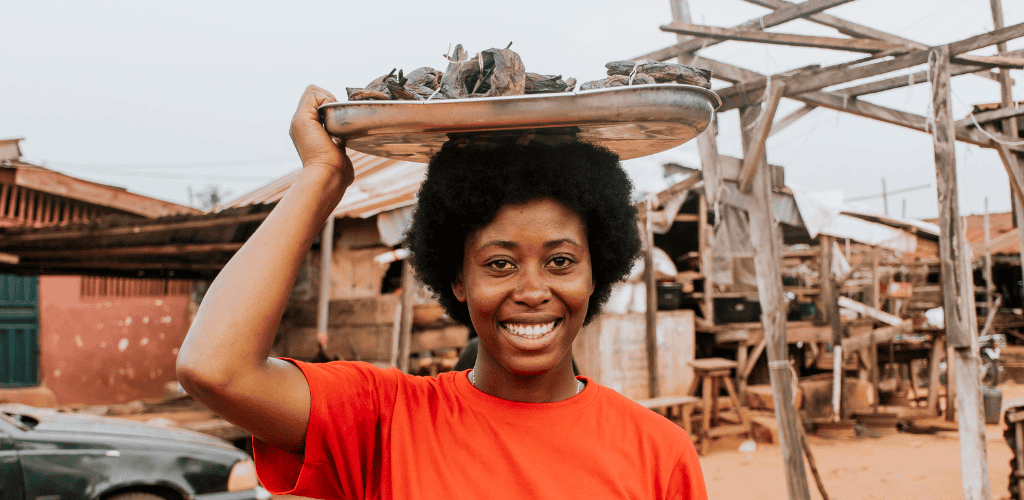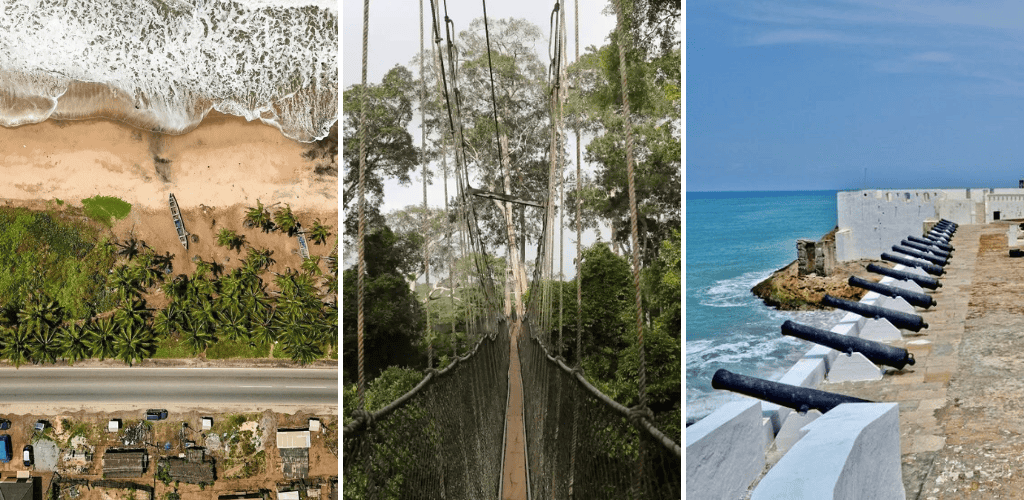In August 1995, Ghana became one of the early African countries to establish full internet connectivity through collaboration with Network Computer Systems (NCS), Pipex International, the Ministry of Transport and Communication, Ghana Telecom, and British Telecom.
Since then, internet access has expanded, driven by mobile broadband, fibre-optic technology, and digital transformation policies. Here’s a roundup of key internet usage statistics, trends, and challenges.
Key takeaways
- By 2025, more than 90% of Ghanaians will have access to the internet, and penetration is expected to reach 98%.
- Mobile internet speeds increased from 7.90 Mbps in 2023 to 13.17 Mbps in 2024, while fixed broadband speeds improved by 21.3%
- Despite growing internet penetration, mobile cellular connections dropped from 43.88 million in 2023 to 38.95 million in 2024.
- While female social media engagement increased slightly in 2024, LinkedIn and X remained male-dominated.
- Ghanaians aged 25-34 used social media the most in 2024.
- Only 30.8% of Ghanaians with internet access engage on social media, meaning nearly 70% use the internet for other purposes.
- Online shopping revenue grew by 8% in 2023.
- In 2023, only 8.4% of primary, 18.7% of junior high, and 39.4% of senior high students had consistent internet access.
General statistics
1. There was an increase in internet speed in Ghana in 2024. (Statista, Data Reportal 2024, Data Reportal 2023)
In 2024, the average internet download speed rose from 12.33 Mbps in 2023 to 16.59 Mbps, a 34.6% increase.
Similarly, the median internet speed increased, as seen in the table below:
| Internet type | Speed (2023) | Speed (2024) | Increase (%) |
| Mobile | 7.90 Mbps | 13.17 Mbps | 66.7% |
| Fixed (Broadband) | 27.70 Mbps | 33.60 Mbps | 21.3% |
Note: The median speed refers to the midpoint of all recorded speeds. Thus, half of the users experienced speeds below these values, while the other half experienced higher speeds.
2. Internet penetration increased in Ghana in 2024. (Data Reportal 2024, Data Reportal 2023)
As of January 2024, the internet penetration stood at 69.8%, up from 68.2% in 2023. This represents approximately 24.06 million internet users, an increase from 23.05 million in the previous year.
Despite this growth, a significant portion, approximately 10.39 million of the population, remains offline.
3. Ghana’s number of active mobile cellular connections declined in 2024. (Data Reportal 2024, Data Reportal 2023).
Interestingly, while internet access increased, active mobile cellular connections declined in early 2024.
Total active mobile connections dropped from 43.88 million in early 2023, representing 129.8% of the total population, to 38.95 million in early 2024, representing 113.1%.
This decline suggests a shift in SIM card ownership patterns, possibly due to the new SIM registration policy, reduced multiple SIM usage, or changing market dynamics.
4. In 2023, 1 GB of mobile data in Ghana cost 0.4 U.S. dollars. (Statista)
In 2023, the average cost of 1 GB of mobile data in Ghana was $0.4. The highest price was $0.73, while the cheapest was $0.08.
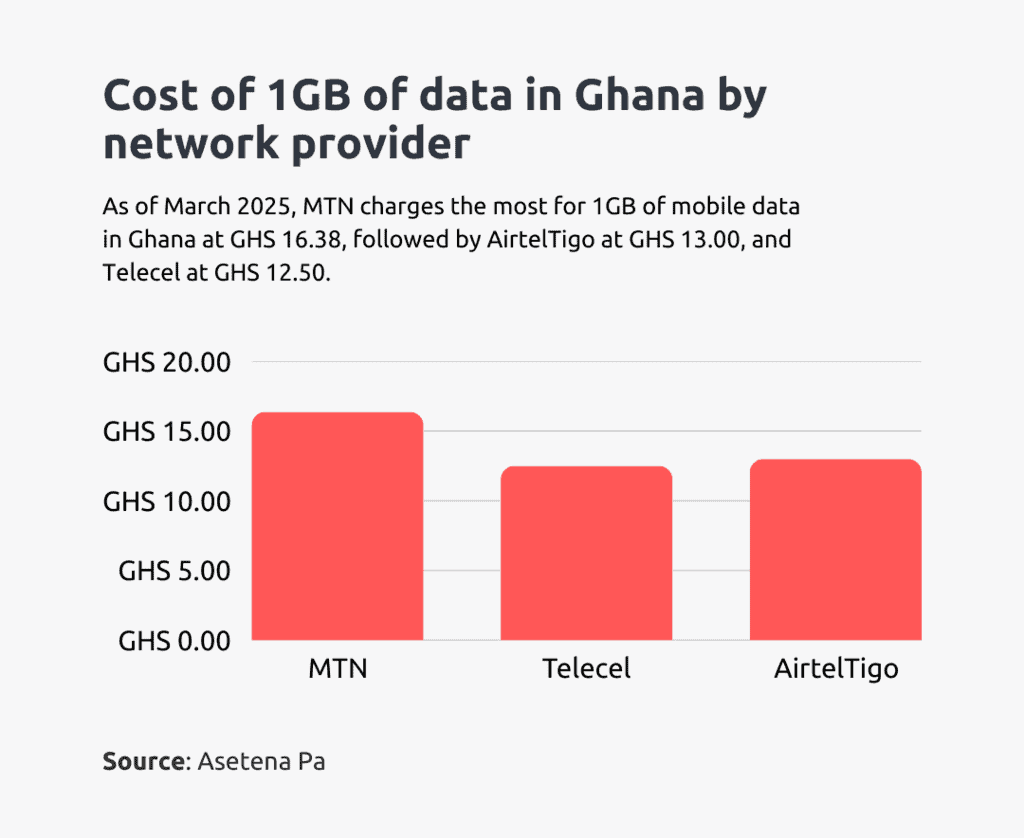
Internet penetration statistics
5. Mobile devices are used primarily for internet access in Ghana. (Statista)
As of January 2025, internet access in Ghana is mostly through mobile devices, representing 77% of the total traffic. Laptops and desktop computers contributed 22%, while tablet usage remained marginal at just above 1%.
6. There was an increase in active social media users in Ghana in 2024. (Data Reportal 2024, Data Reportal 2023)
Ghana witnessed a growth in active social media users from 6.6 million in January 2023 to 7.4 million in January 2024 (58.8% were male, while 41.2% were female). This 12.1% increase reflects the rising adoption of digital platforms for social networking and content consumption.
7. Social media users across platforms increased in 2024. (Data Reportal 2024, Data Reportal 2023).
Data from advertising resources of major social media platforms showed a rise in reported user numbers in early 2024.
Below is the breakdown:
| Platform | Users in 2023 (million) | Users in 2024 (million) |
| 1.70 | 2.20 | |
| 2.10 | 2.60 | |
| X | 1.15 | 1.17 |
| 5.65 | 7.40 |
Note: The total number of users across platforms exceeds the reported active social media user base due to multi-platform usage, where individuals maintain accounts on multiple platforms.
8. Most internet users in Ghana used WhatsApp in the third quarter of 2023. (Statista).
In the third quarter of 2023, 91.8% of internet users actively engaged on WhatsApp. Facebook was the second most-used platform, attracting approximately 77.4% of users, followed by TikTok, which had a user base nearing 70%.
9. Social media usage in 2024 varied by device. (Statista, Statista, Statista).
In January 2024, social media usage in Ghana varied significantly across different devices. Among desktop users, YouTube was the most used platform, with 66% usage, followed by Pinterest with 14% and Facebook with 8%.
On the other hand, tablet users preferred Pinterest the most, with 35% accessing it, followed by Facebook with 27% and YouTube with 25%.
Facebook was the most popular social media site on mobile devices, with 28% of users accessing it. YouTube was next with 27%, and Twitter was third with 17%.

10. 30.8% of Ghana’s internet user base used at least one social media platform in 2024. (Data Reportal 2024)
As of January 2024, 30.8% of internet users engaged with at least one social media platform in 2024. This implies that while social media is widely used, 69.2% of internet users still do not actively engage on these platforms.
11. In 2024, more males than females engaged with advertisements across social media platforms in Ghana. (Data Reportal 2024, Data Reportal 2023)
In 2024, the percentage of male social media ad audiences across most platforms decreased, whereas females increased. Despite this, male users dominated social media ad audiences in both years.
Here’s the breakdown:
| Platform | Males | Females | ||
| 2023 | 2024 | 2023 | 2024 | |
| 58.5% | 46% | 41.5% | 44% | |
| 65.3% | 61.2% | 34.7% | 38.8% | |
| 65.1% | 65.4% | 34.9% | 34.6% | |
| X | 79.1% | 77.6% | 20.9% | 22.4% |
| Youtube | – | 58.9% | – | 30.8% |
Although there’s a gradual shift towards gender balance on these platforms across the two years, LinkedIn remained male-dominated with little change, indicating that professional networking platforms still attract more men.
X also continued to have the highest male user base despite a slight increase in female engagement. This reflects content preferences related to politics, tech, and public discourse that dominate the platform.
12. More people viewed Facebook Messenger ads in Ghana in 2024. (Data Reportal 2024, Data Reportal 2023)
Data published in Meta’s advertising resources indicate that ads on Facebook Messenger reached 1.10 million users in Ghana in early 2024, up from 885,500 in January 2023, a 24.2% increase.
13. In 2024, most social media users in Ghana were between 25 and 34 years old. (Statista, Statista, Statista)
In December 2024, users aged 25-34 accounted for the largest share of Facebook, Instagram, and LinkedIn users in Ghana.
| Platform | Age group | |
| 18-24 | 25-34 | |
| 31.7% | 35.7% | |
| 36.9% | 39.5% | |
| 35.1% | 51.1% | |
14. As of December 2024, there were over 2.3 million Instagram users in Ghana. (Statista)
According to Meta’s advertising tools, Instagram had 2.20 million users in early 2024. By December 2024, the number had surpassed 2.3 million, representing about 7% of Ghana’s population.
15. As of December 2024, there were approximately 3.1 million LinkedIn users in Ghana. (Statista)
In early 2024, LinkedIn had 2.60 million members in Ghana. By December 2024, the number of users had grown to 3.1 million, representing 9.2% of the country’s population.
Internet usage statistics
16. As of 2022, Ghana’s e-commerce market penetration rate was 27.41%. (Citi Business News)
Ghana’s e-commerce market penetration rate reached 27.41% in 2022. Despite this progress, many internet users have yet to fully embrace online shopping.
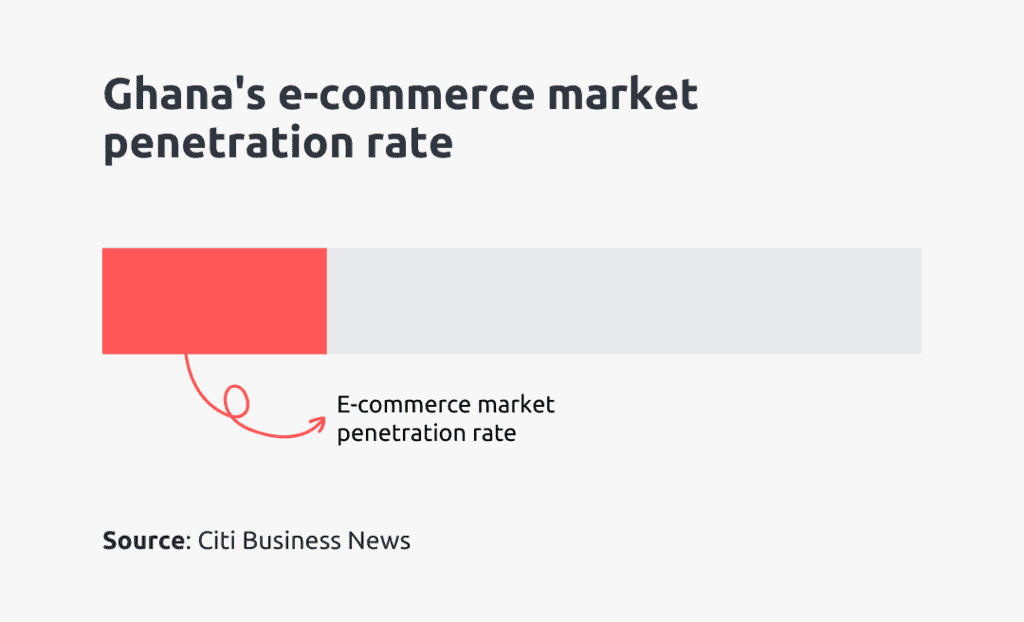
17. 10 million consumers in Ghana made digital payments in 2023. (Statista)
By 2023, an estimated 10 million consumers in Ghana had made digital payments, marking a shift toward cashless transactions. This increase aligns with rising internet access and the adoption of mobile money services.
18. E-commerce revenue increased by approximately 8% in 2023. (Enspire)
Between 2022 and 2023, e-commerce revenue in Ghana increased by 8%, with the fashion and electronics sectors contributing the most.
In 2022, the electronics e-commerce category recorded over 9 million monthly visits, while the fashion category had an average of 141,000 visits.
19. In the third quarter of 2022, less than half of Ghana’s internet users made online purchases. (Enspire)
Around 24% of internet users purchased a product or service online in the third quarter of 2022.
20. Less than 50% of primary, junior high and senior high school students had consistent internet access in Ghana in 2023. (Wathi)
In 2023, less than half of primary, junior high and senior high school students had consistent internet access for teaching and learning purposes.
The breakdown of internet accessibility per school level was:
- Primary schools: 8.4%
- Junior High Schools: 18.7%
- Senior High Schools: 39.4%
Although the lack of widespread internet availability in schools presents a significant barrier to digital literacy and e-learning adoption, initiatives like the Ghana Smart Schools Project are set to change the status quo.
21. In the third quarter of 2023, almost all internet users in Ghana watched videos online weekly. (Statista)
A survey found that 96.6% of internet users in Ghana watched various types of online videos every week in Q3 of 2023.
Of these, 59.2% watched comedy, meme, or viral videos, while 27.6% watched educational content. The least-watched video category was product reviews, which attracted only 12.4% of internet users.

22. In the third quarter of 2023, four out of ten internet users in Ghana watched online music videos weekly (Statista).
A survey conducted in Ghana found that 38.1% of internet users watched or listened to online music videos in Q3 2023. Also, about 15.2% streamed music on platforms like Spotify and Apple Music, 10.4% listened to podcasts, and 9.7% listened to audiobooks.
23. Millions were spent on digital products in Ghana in 2023 (Statista).
In 2023, Ghana’s video game downloads and subscriptions totalled about $122 million. That same year, about $98 million was spent on video-on-demand (VOD) services and $33.5 million on e-publishing.
Projected internet growth
24. More than 90% of Ghanaians will have access to internet in 2025. (Statista)
Ghana’s internet penetration rate is expected to reach 98% by 2025, reflecting the country’s significant growth in digital access.
25. There will be an increase in accessibility of home internet in 2025. (Statista)
The number of households with internet access is projected to reach 8.08 million by 2025.
26. 3G network coverage in Ghana will reach 100%. (Statista)
Projections indicate that by 2025, 3G network coverage in Ghana will reach 100%. Meanwhile, 4G network coverage is expected to expand to 78.15%, further improving high-speed internet availability nationwide.
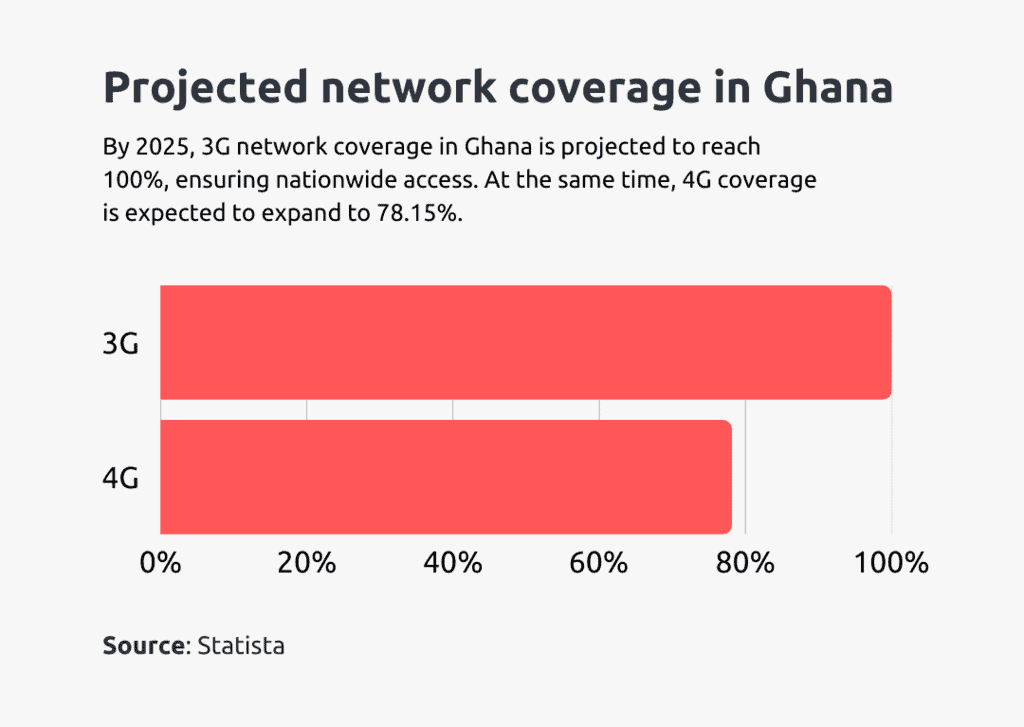
27. There will be an increase in broadband connectivity speed in Ghana in 2025. (Statista)
As Ghana’s internet infrastructure develops, broadband speeds are projected to increase, with the average broadband connection speed estimated to reach 14.45k kbit/s in 2025.
Internet outages and challenges
28. There was a major internet outage in 2024. (NCA, BBC)
In March 2024, Ghana experienced a significant internet outage due to damage to multiple submarine fibre optic cables along the West African coast. This reduced internet connectivity to 25% of normal levels.
FAQs
What internet services are available in Ghana?
Internet services available in Ghana include mobile (3G, 4G), broadband (fibre and wireless), and satellite.
Which internet service provider has the fastest speed in Ghana?
As of 2024, MTN Ghana has the fastest mobile internet speeds (28.4 Mbps average download speed), while Starlink leads in broadband speeds (74.2 Mbps average download speed).
What is Ghana’s digitalisation effort?
Ghana’s digitalisation effort includes the 5G network launch, project Taara, and Digital Agenda 2030.
Conclusion
Internet usage in Ghana is expanding rapidly, with increasing penetration and faster speeds. However, challenges like the rural-urban divide and cybersecurity must be addressed to ensure overall growth.
What do you think about the progress of the internet? Do you face any challenges with internet access? Share your thoughts in the comments.
